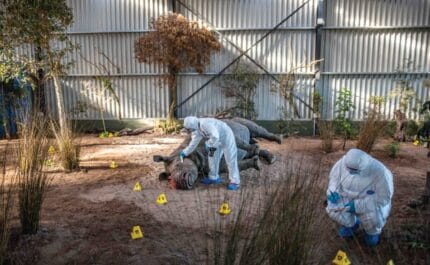The rollout: 2. The cathedral converters
On 25th March 2021 the government made its first announcement about the efficacy of the UK’s mass vaccination programme, estimating that it had prevented more than 6,000 deaths in England alone. By the end of June that number had increased to over 30,000 and counting. The biggest mass vaccination programme in the UK’s history has been driven by an extraordinary collective effort – to see what it took we spoke to people who administered jabs, set up vaccination centres, tested treatments and dispelled misinformation to help chart a path out of the pandemic

Members of the public receive a dose of a Covid-19 vaccine at Salisbury Cathedral, 20th January 2021 (Photo by Finnbarr Webster/Getty Images)
25th Mar 2021 (Taken from: #42)
This is the second part of a four-part series. See also our profiles of the district nurse bringing hope to vulnerable patients, the researcher combating vaccine disinformation and the volunteers putting their bodies on the line for new jabs
Jo Pike, Rob Douglas and Marie Narang
Workers at the Salisbury Cathedral vaccine site
“2020 was meant to be a year of celebration at Salisbury Cathedral. “It was the 800th anniversary of the laying of the foundation stone,” says the cathedral’s events manager Jo Pike. “We had been working on marking the occasion for four years and had so much planned – a lovely big flower festival, organ concerts; an art exhibition was being installed right at the moment the cathedral closed [due to Covid restrictions]. It was heartbreaking.”
The closure of the world-famous landmark was a blow for a Wiltshire town whose population had been left shell-shocked three years earlier by the poisoning of former Russian intelligence officer Sergei Skripal and his daughter Yulia. The cathedral reopened to the public in July 2020, with social distancing measures in place, but shut again in November as a new wave of infections hit the country. Just before Christmas the dean of the cathedral heard that the NHS wanted to use the site as a pop-up vaccination centre.
Pike and cathedral floor manager Rob Douglas converted the building in collaboration with the local NHS primary care network. “We had to think about entry and exit points, one-way systems, health and safety, and changing areas for the clinicians,” says Marie Narang of Salisbury Medical Practice, who ran the operation from the NHS side. “And then there were added considerations such as patient privacy and how that would work in such an open-plan area, and where to have a treatment bay if somebody was taken unwell.” Despite many logistical challenges – the wifi was spotty, power supplies were limited and it was so cold Narang said “the ski gear came out” – it offered some advantages over her usual place of work. “We’d been struggling with social distancing at our practice all year,” says Narang. “The cathedral had a vast amount of space, which made it much easier.”
“We saw people who hadn’t left their homes in nearly a year, all dressed up in their finery – it was really lovely”
On 16th January the cathedral reopened as a vaccination centre – and over 1,000 patients, mostly aged over 80, arrived for their first dose. “We saw people who hadn’t left their homes in nearly a year, all dressed up in their finery – it was really lovely,” recalls Douglas. “We had the Christmas tree up, as well as the nativity scene [a large silk picture hanging from the ceiling] and organ music,” adds Pike. “Some people arrived anxious but they sat in the nave and immediately felt calm.”
On that first day the team worked nearly 14 hours. “It was a long day, but we were on such a high,” says Douglas. “Whenever I had a spare minute I’d look at Twitter and see how high we were trending. And then I’d see that we were on CNN.” An aerial photo of people getting vaccinated in the cavernous nave made the front page of the New York Times. It became a global news story, a symbol of hope in difficult times.
Few publications or news channels failed to mention John Challenger’s eclectic musical repertoire. The cathedral organist, with the help of director of music David Halls, treated vaccine recipients to perhaps the only live public musical performance taking place in the country. “John and David were inundated with requests,” recalls Pike, adding that the pair played show tunes, music hall songs and even Take That and Oasis hits in addition to works by Bach, Mozart and Handel. “People who got Pfizer would sit and listen to the organ music during the 15-minute cool-off period, but we found that many people who got AstraZeneca didn’t leave straight after their jabs because they wanted to listen to it too,” she says.
At the start of May the NHS team carried out its last vaccinations before moving to another site nearby. After a difficult year Narang’s team had received a huge morale boost from their time in the 13th-century cathedral. And when it did reopen to the public as a place of worship, it seemed that its time as a medical centre had brought unexpected consequences. The overseas tourists may not have returned, but visitor numbers are rising. “So many people told us that they’ve lived in Salisbury their whole lives and barely ever stepped inside here,” says Douglas. “Now they want to visit more often. The vaccinations have reunited local people with the cathedral.”
Slow Journalism in your inbox, plus infographics, offers and more: sign up for the free DG newsletter. Sign me up
Thanks for signing up.








